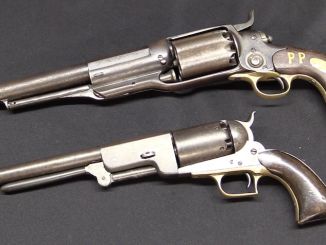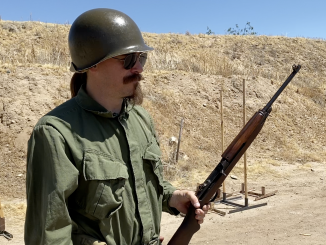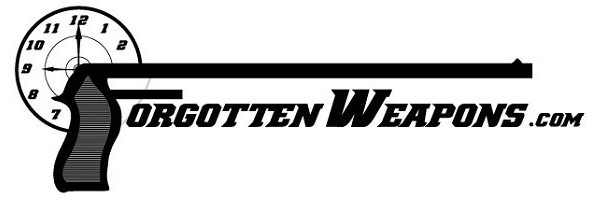We’ve all heard about how the Winchester 1897 is capable of slam fire, but is that really a useful feature? Or is it just a cost-saving safety hazard? Well, Matt Haught of Sym-Tac consulting and I are at the range today to find out…
Related Articles

Conversion
Biggest Revolver Yet? A 10-Gauge Colt 1855…

Competition


Omitting a disconnector (using a simple hammer / trigger FCG like an SA revolver) wouldn’t create slamfire capability; just useless and annoying hammer follow.
The animation on C&Rsenal’s 1897 video shows there is clear disconnection as the action pivots the sear out of alignment with the trigger, reconnecting only when coming into battery – comparable in effect to an “auto sear” in a hammer-fired full auto.
There are a lot more differences than just the disconnector on those two. A good comparison would be an 870 and a Model 12 made in 1960 or so with the same barrel lengths and capacity. Neither ported of course. Add to that a shooter that is proficient with both. As for all the talk about safety….wow. Unless a firearm goes bang when it shouldn’t then the proper use of it is entirely the responsibility of the operator. Great effort anyway Ian. Thank you for what you do.
Ithaca 37s had the capability ( the way JMB intended)until 1975. All 37s manufactured after that had the disconnect redesigned into them.
Was there any prior lawsuit launched due to presence of said feature inside Ithaca Model 37?
“(…)all heard about how the Winchester 1897 is capable of slam fire(…)”
Were U.S. soldiers aware of that in 1917? Was such disclaimer placed in manual or textbook used in 1917? If no is there any evidence that any U.S. soldier in 1917 detected such possibility and if yes was such information propagated?
I have an old Ward’s Western Field in 20 Gauge (built on a 12 Gauge frame) inherited from a grandparent, which also has no disconnector and will slam fire. I’ve tried it a couple of times, just to see what would happen, but would not want to try using it that way for self defense.
Had an early 50s production Ithaca model 37. The slam fire would always catch me off guard the first day of dove season. Seemed yo me to be more of a safety concern than any sort of benefit
Capstick promoted the slamfire ability with his Model 12. Against a charging animal he said it was an advantage.
I had once bought a longer barreled winchester 1897 from a fellow who said he found the slam fire useful for follow up shots rabbit hunting. Quite sadly I unwisely parted with the gun before I could really test this.
I used an original Model 1897, 28″ barrel, improved cylinder bore, inherited from my father, as both a duty gun and for trap shooting. I did find that the ability to instantly fire a second shot by simply pumping the action made doubles in trap easier than it probably should be under the rules.
The major limitation of the 1897, of course, was that small, slippery pump. Most pump shotguns since then haven’t really had ones that were any better designed, except ones like the 870 shown here. Larger forearms tended to be very slick, mainly for “looks”. Smaller ones tended to copy the 1897 or Model 12 forearm because “tradition”.
I doubt that most shotgunners have ever known that that skinny forearm, with the grooves that are the only thing you can actually get a semi-solid grip on, date to the very first commercial pump action shotgun, the Spencer Model 1882;
https://warisboring.com/wp-content/uploads/2018/09/Image0000716-e1537823452353-970×350.png
The first version and second version (top two) had very small “pump” handles. The third version (bottom) was introduced in 1890 to alleviate the obvious drawbacks of same.
It’s ironic that it took about a century for designers to figure out how the “pump handle” of a shotgun should be shaped to properly fit a human hand. As opposed to just looking elegant.
clear ether
eon
The U.S. Navy SEAL teams during the Vietnam War were reportedly in favor of the older-model Ithaca 37 shotgun because the ability to rapidly cycle and fire it by holding the trigger down and working the foregrip enabled them to rapidly dispense a large amount of firepower in tight situations such as a close quarters ambush. Creating a very loud, immediate and massive distraction with psychologically and potentially life-threatening consequences for the enemy may have been just as important as actually hitting them directly when it came to breaking up and tactically altering said situation. The input of any former SEALs with this type of experience would be invaluable.
Just a thought, I would like to have seen a set of runs done with the trench gun where the slam fire was not used but normal single shot trigger pull used if this is practical.
This would have given us a direct comparison between the slam fire and controlled shot on the same gun and comparison to a modern weapon.
This would allow us to see if slam-fire gave any advantage to a user of the same weapon and how much advantage a modern weapon had under the same conditions,
“Farm boys” had single barrel shotguns, at $5 or so apiece. The ’97 was four times the price, approaching $20. That’s about a thousand dollars worth of current purchasing power, a cheap new car was $500.
’97s weren’t cheap hand me downs until the 1960s.
A slamfire is ONLY an M1 or M1 type open to the top action that fires OUT OF BATTERY. Very different and normal, is a firearm firing normally; older pump actions that mimic in function, the absolutely normal pass-off that prevents closed bolt full automatics-and almost all older pump guns from firing out of battery.
Now, shooting damn quick trigger locked pulled: it’s always done from the hip. Picture meeting a VC or NBA on a jungle trail at 5 to 40 feet: From hip, point and pump like hell because your life DOES depend on it. My practicing used up quite a few cases of 12 gauge buckshot and slugs in 1969 near Dong Tam, RVN. And occasionally I still do birdshot demos while training bear defense shooting, using gallon milk jugs at 10 to 50 feet, waist level. Not 100%, but infinitely better than nothing.
In the 1980s my Dad gave me his 20 gauge Winchester model 1912 (manufactured in 1915). He had told me many times that he traded a German pistol for it after he came home from overseas during WW2. All those years I never knew it would slam fire until about five years ago. I tried slam firing a few times… would be tough for me to get used to.
The slamfire was not tested from firing from the hip. Considering the use in a narrow trench, I really don’t think shouldering the shotgun was the most used firing posture. Operating the slamfire from the hip would seem ergonomically more practical.